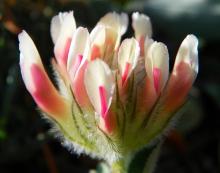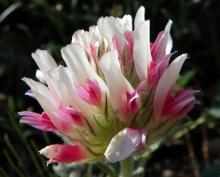When I lived in the Seattle Washington area, it was a mere 2 hour drive to get up into the dry Wenatchee Mts (a spur off the Cascades), where there was lots of Lewisia tweedyi in some strong yellow and peachy-yellow shades (the guys at Grand Ridge Nursery found forms that were yellow strongly tinged red). From there we'd move along to another area, and my wife and I would go "rediviva" spotting, along with Fritillaria pudica, Sisyrinchium douglasii, eriogonums and penstemons... all the good stuff, and astragali too, but the most memorable plant is Trifolium macrocephalum; dwarf but with enormous heads in orange shades rather than the more typical pink, but nearly ungrowable as I've tried it. In the first link, the flowers are salmon color, but not quite as orange sunset-hued as the plants I remember in the Wenatchees. Does anyone grow this successfully.
http://plants.usda.gov/java/largeImage?imageID=trma3_003_ahp.tif
...excellent photo essay here:
http://wolves.wordpress.com/2008/05/19/big-head-clover-trifolium-macroce...
...another excellent photo essay here:
http://science.halleyhosting.com/nature/gorge/5petal/pea/trifolium/bighead.htm
gorgeous bright pink-flowered specimen on CalPhotos
http://calphotos.berkeley.edu/cgi/img_query?enlarge=0000+0000+0508+1561
Comments
Re: Big Head Clover - Trifolium macrocephalum
We're all hoping someone grows it and will put seed into the seed exchange - stunning plant.
Re: Big Head Clover - Trifolium macrocephalum
I found the following link, a fellow that lives in Washington State's Columbia Basin (Ellensburg) and has offered seed for sale of plants from the area. The web page is for 2008, thus outdated, and the seed availability for Trifolium macrocephalum says "sold out". Judging from the home page, it appears that he will collect seed by request, if in fact, he's still in business.
Re: Big Head Clover - Trifolium macrocephalum
It's available from Alplains, along with a number of other exquisite Trifolium.
http://www.alplains.com/
Re: Big Head Clover - Trifolium macrocephalum
Mark
The populations around Reno are the pink ones, the orange colored population you describe sound great. I am trying again this year to move it into the garden. I dug some runners early in April, they still have a few green leaves at this time. I have my fingers crossed that they root. I have tried to move them several times in the past to no avail.
It is hard to get good starts as the grow in very rocky soil. The roots run but also send down deep taproots.
I do grow one species of western dry land Trifolium. Trifolium andersonii
Re: Big Head Clover - Trifolium macrocephalum
So Trifolium macrocephalum is rhizomatous, then? Not too rambunctious, though, I trust?
Re: Big Head Clover - Trifolium macrocephalum
In their native dry habitat they run moderately you will find shoots popping up about every six to eight inches apart. They do not put out a lot of top growth maybe three or four stems, about four to five inches long sprawling out across the soil surface. Leaves are the typical clover shape with pale green chevrons over laying the darker green leaf surface. The leaves are spaced about an inch apart along the stems. I would describe it as a moderately rhizomatous, slow spreading, open ground cover, for a dry sight. I do not think it would become ramped in a dry sight doubt it would survive a very moist environment, at least I have never seen it growing in one. It is found growing with Lewisia rediviva, Viola beckwithii, Astragalus purshii, and Phlox stansburyi.
I hope I will be able to tell you more next year. I planted it away from choice alpines on a bare slope just to play it safe.
Re: Big Head Clover - Trifolium macrocephalum
These dryland trifoliums are a favorite of mine. We have, not for from here, a trifolium called Trifolium Owyheense. It used to be lumped with macrocephalum but was deemed a true species, which is most certainly valid. It has been considered for listing as endangered since the entire population occurs in one drainage that straddles the Idaho/Oregon border in the Owhyhee uplands. On top of that this clover only grows in a very specific ash layer that is snow white and has few plant species growing in it the layer is exposed in a few places by erosion of a small creek. The Idaho population is all in one spot of a few hundred square yards with maybe 100 plants total. The Oregon population is disjunct, occurring in the same ash layer several miles from the Idaho population the Oregon population is larger than the Idaho population, still not many plants. Here is a picture from my garden of this plant:
Jim
Re: Big Head Clover - Trifolium macrocephalum
Thanks Jim, for showing us this interesting (and attractive) and apparently very rare dryland clover species, and for providing the background information. It is a species that I'm not familiar with, so I googled and found some more info. One thing I learned from the PDF link below is that T. macrocephalum has 5-8 leaflets, and owyheense has just 3 leaflets.
zoomable herbarium specimen, if you want to see what it's doing underground:
http://oregondigital.org/cdm4/document.php?CISOROOT=/herbarium&CISOPTR=1...
The status of T. owyheense in Idaho
https://fishandgame.idaho.gov/ifwis/idnhp/cdc_pdf/u01man08.pdf
Re: Big Head Clover - Trifolium macrocephalum
Jim
Great to hear from you about this rare Trifolium. It is a shame that it's habitat in Idaho is threatened. I hope the authorities midigate the situation with the mining interests.
It looks like a choice little clover. I like the flower rich color.
Great to see your post Jim and welcome back from your trip.
Re: Big Head Clover - Trifolium macrocephalum
Thanks for the kind comments. I have to admit that I have not kept up with the status of this plant. There may be more plants in Idaho than I thought though I did look at most of the areas where I thought it might be, thanks to google earth. Two years ago I went to collect some seed from the population that I know of. I had found earlier in the season that there were plenty of plants in flower and expected good seed set. I was disappointed to find on my return that all but one of the plants had been mowed down by grazing and only located one plant that was missed and was with seed--- I left it alone. Unfortunately these plants are heavily impacted by severe overgrazing and trampling by livestock. Oddly the Idaho penstemon, Pentstemon idahoensis occurs in a very similar ash layer in the Goose creek drainage(a couple hundred miles southeast of here) and suffers from the same problem. I hope at least my plants will have good seed set this season.
Jim
Re: Big Head Clover - Trifolium macrocephalum
Jim
What method do you use to separate the seed from the heads? When I collect seed from Trifolium andersonii, I find it a time consuming task. I rub the heads of between gloved hands pulverizing it as much as I can. Then sift out the fine chaff and run a pinch at a time through my finger tips to find the hard membrane sheathed seed. At this point I can rub the membrane off each seed.
It takes a lot time to collect enough seed to send to the exchange. Just thought you may have a better way.
Been off the forums for quite
Been off the forums for quite a while now so i am just getting back engaged. i have not found a better way than you have. in the case of the plants in my garden it seems that the pollinators are not efficient for this plant so i have to go through a good bit of chaff to find even a few viable seeds. Here is a better picture of one of my colonies of this plant.
Jim
Jim
That is a nice patch and let me say again how much I like it's intense rich coloration. Here are a couple of photos from the Trifolium macrocephalum I am finally getting established in my garden you can see how much softer the coloration is.
Those look pretty nice. I
Those look pretty nice. I think the trick to keeping this plant happy is to let it get real dry when it dies back in summer. Like so many great basin species even a little soil moisture during summer dormancy can cause permanent dormancy.




Wow, I wish I could say that I do grow it, but I have not tried it. Spectacular!